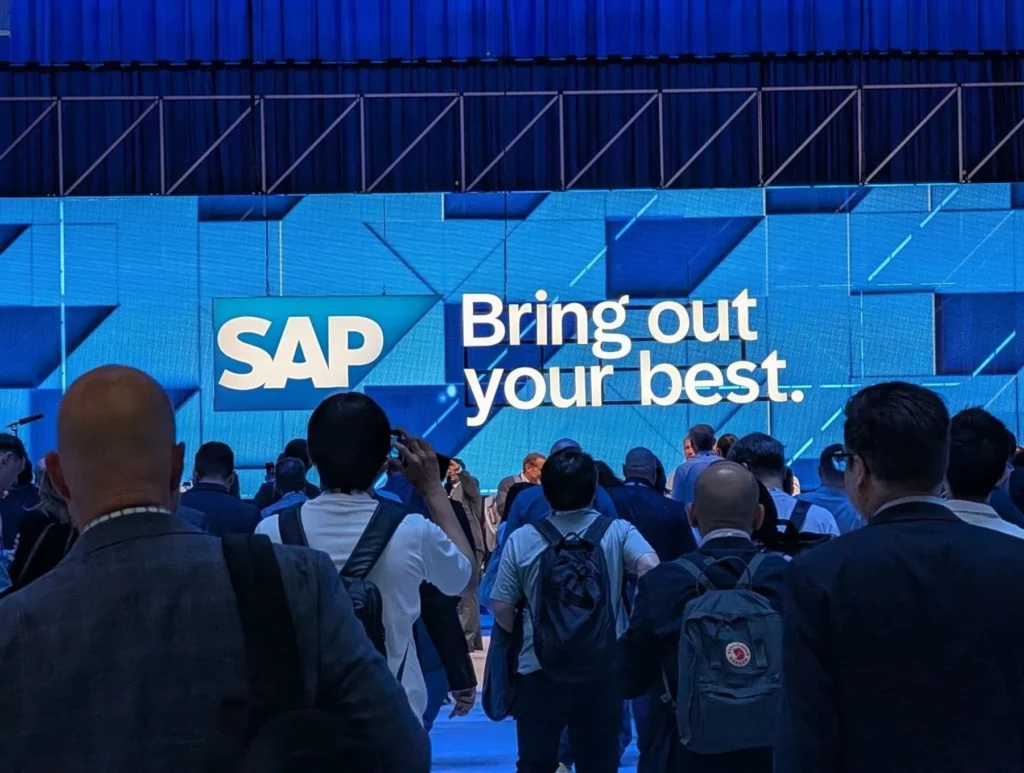Are pickings getting a whole lot slimmer for the big ERP software vendors? With businesses stacking software like never before, vendors are vying for as many elements of the technology tower as possible. But it seems the days of having a one-catch-all software vendor have passed, making markets harder to crack for the big ERP players, as organizations instead choose to build multiple layers of more specialist technology.
A good example of a diversified tech stack in action is that of Travis Perkins, the British builders’ merchant, construction and home improvement Goliath. Drawing a map of Travis Perkins’ systems looks a little like a spaghetti junction. Rocket Software, SAP Hybris, LeanIX, ServiceNow, SAP Signavio, OneTrust, Slack, and more are scattered across the business.
Sitting down with Travis Perkins team members at the recent UKISUG conference in Birmingham, ERP Today learnt from Matt Webb, head of business process improvement, and David Crooks, enterprise architect, about the change of mindset in the firm’s tech stack tactics.
“The business has got a complicated structure and culture, and it’s got an old, aging in-house built ERP system that’s 45 years old,” reveals Webb. “The strength is that it has been built over 45 years to do exactly what we thought we wanted it to do. It’s probably made it slightly more complex at times. Certainly, when you’re looking at moving to another system, it means you’re trying to bring a lot more baggage with you.”
Many might wonder why the business doesn’t choose to simplify its stack. But when you consider the sheer number of failed technology implementations, you can start to understand the caution. Not immune to this kind of nightmare scenario, Travis Perkins has experienced its own major implementation crisis.
“Our attempted ERP transformation with Infor got canceled after quite a long, long time,” says Webb. “It was a big transformation. Moving from a business that was used to doing things its own way, to try and standardize – it was a scale issue from both sides.
“I think that’s probably where you started feeling the implementation go wrong, where it started off as a business transformation and ended up as an IT transformation because of all the complications. That’s not the cause of it, but that’s where you start to feel that it’s now not changing the business, it’s instead being driven by the IT system in the background.”
As one can imagine, things ended stickily, lawyers were called, and the implementation was halted. After a worst-case ending of attempting to install an all-encompassing system, Travis Perkins decided to change its implementation tactics for good. Sticking with its rather vintage built-in-house ERP system, the business’ leaders then tackled the challenges piecemeal, slowly building a workable solution brick by brick.
Travis Perkins is rocked by similar business concerns affecting many others in its field: 38 percent of global emissions are caused by the construction industry, for one, and with the average construction worker aged over 50, there is a graying workforce with more skills gradually leaving each year.
“Strategy-wise we’re looking to be a leading partner of the construction industry moving forward, and understand more ways of getting people in, reducing environmental impact, and modernizing finance. We are looking to build out our process model slowly over time, which in the future hopefully leaves us in a place where we can be more agile because we know where we are and therefore it’s easy to work out how to get to where we want to be,” says Webb.
It’s true, whether for the sake of reducing either costs or implementation risk, companies are focusing on improving certain business target areas. Keeping legacy ERP systems and narrowing down new software purchases to specific requirements, is enabling businesses to step up capabilities as required, and build solutions in a more agile, safer, piecemeal way.
For Travis Perkins, SAP Signavio was the best option in targeting its finance modernization in 2020. Three months later, the system was live with employees in training.
“As a cloud system, there was nothing to replace as such. Now, if you took the straw poll of my team, you’ll get 100 percent confirmation that using it is definitely quicker,” explains Webb.
It was a similar case with the firm’s choice of LeanIX software. “The most integration that we’ve implemented so far is the out-of-the-box integration with the LeanIX enterprise architecture management tool,” says Crooks. “Literally, turn it on and we can configure the levels of information or the paths across what we’re building out in the LeanIX environment for applications or software. We’re now getting consistent, so when Matt’s calling it a spade, I know it’s a spade.
“LeanIX doesn’t position itself as being all things to all men. It knows what its strong points are. It’s not trying to do everything, and that’s what I quite like about the model.”
For Crooks, the days of a big bang transformation are definitely gone. “We don’t want it to be the master of everything,” he says. “It’s a slow burn. We’re adding extra attributes to our capability model now to be able to understand what good looks like. It’s making sure that we’re looking at the right thing at the right level, and building that platform to really start making better, educated decisions.
“This is not a technology discussion. This is more of a business mindset change, and that’s a problem not just for Travis Perkins to solve, but for a lot of organizations. It’s finding the balance between two things – there are things that we need to differentiate on because that’s our place in the market and our unique selling point to customers. But there are plenty of other things that actually aren’t, so finance, HR and all sorts…that we could be doing at the same level.”
For the Travis Perkins team, this doesn’t mean a resounding rejection of all big ERP vendors, and the business is considering further SAP applications moving forward. However, for now, each implementation is set to stay on a brick-by-brick basis, with control remaining in the hands of the business.
To keep hold of the market, it would seem that the likes of SAP, Oracle, and others have a choice. Collaborate with these layering capability vendors, or compete. Catching an aside with Michiel Verhoeven, the managing director of SAP UK&I, I asked for SAP’s take.
“Customers do not need to believe that they should get everything from SAP,” says Verhoeven. “The best way to get value out of SAP is the clean core ERP – your S/4HANA, supply chain, Signavio, and BTP, and then your best-of-breed third-party applications integrated around it.
“Do we see some of them as competitors? Of course, I mean, they are competitive – we have an HSM solution, a supply chain solution; there’s a lot of competition in the space. There’s a lot of demand in that space, too. We believe we have equally great best-of-breed solutions, but that’s for the customer to decide, right?”



